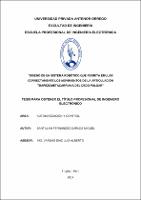Mostrar el registro sencillo del ítem
Diseño de un sistema robótico que permita emular correctamente los movimientos de la articulación trapezometacarpiana del dedo pulgar
| dc.contributor.advisor | Vargas Diaz, Luis Alberto | |
| dc.contributor.author | Santillán Fernández, Carlos Miguel | |
| dc.creator | Santillán Fernández, Carlos Miguel | |
| dc.date.accessioned | 2015-03-18T21:45:51Z | |
| dc.date.available | 2015-03-18T21:45:51Z | |
| dc.date.issued | 2014 | |
| dc.identifier.uri | https://hdl.handle.net/20.500.12759/648 | |
| dc.description.abstract | En el documento se define o aclara las características o técnicas de diseño, para crear un sistema que emule el movimiento del dedo pulgar de una mano humana. Sin embargo solo se validará el movimiento de la articulación trapezometacarpiana del dedo pulgar. Está validación se realizara, construyendo dicho sistema robótico y a su vez controlando los dos movimientos que realiza la articulación. Este diseño pertenece al de una mano robótica no auto contenida, es decir que todos los actuadores van a estar fuera y no dentro de la mano robótica (palma). El dedo pulgar va a estar compuesto por 5 grados de libertad, pero debido a que solo se controlará la articulación trapezometacarpiana, solo se utilizarán los dos últimos grados de libertad. La articulación estará controlada por tendones o cables, que a su vez estarán controlados por motores DC de 12 voltios. El sistema de control va a estar constituido por microcontroladores PIC 16F877A. La interfaz no se realizará debido a que se cuenta con posiciones definidas del dedo pulgar, en cada una de las cuatro ubicaciones frente a los demás dedos. | es_PE |
| dc.description.abstract | The paper defines and explains the features and design techniques to create a system that emulates the movement of the thumb of a human hand. However, only the movement of the thumb joint trapezometacarpiana be validated. Validation is carried out, said building robotic system and in turn controlling the two movements made by the joint. This design belongs to a robotic hand is not self contained, meaning that all actuators are to be outside and not within the robotic hand (palm). The thumb will be composed of 5 degrees of freedom, but because only the trapezometacarpiana joint control, only the last two degrees of freedom are used. The joint will be controlled by tendons or wires, which itself will be controlled by 12-volt DC motor. The control system will consist of 16f877A PIC microcontroller. The interface is not performed because it has thumb defined positions, in each of the four locations over other fingers. | en_US |
| dc.description.uri | Tesis | es_PE |
| dc.format | application/pdf | es_PE |
| dc.language.iso | spa | es_PE |
| dc.publisher | Universidad Privada Antenor Orrego - UPAO | es_PE |
| dc.rights | info:eu-repo/semantics/openAccess | es_PE |
| dc.source | Universidad Privada Antenor Orrego | es_PE |
| dc.source | Repositorio Institucional - UPAO | es_PE |
| dc.subject | Movimientos de la articulación trapezometacarpiana | es_PE |
| dc.subject | Dedo pulgar | es_PE |
| dc.title | Diseño de un sistema robótico que permita emular correctamente los movimientos de la articulación trapezometacarpiana del dedo pulgar | es_PE |
| dc.type | info:eu-repo/semantics/bachelorThesis | es_PE |
| thesis.degree.level | Título Profesional | es_PE |
| thesis.degree.grantor | Universidad Privada Antenor Orrego. Facultad de Ingeniería | es_PE |
| thesis.degree.name | Ingeniero Electrónico | es_PE |
| thesis.degree.discipline | Ingeniería Electrónica | es_PE |
Ficheros en el ítem
Este ítem aparece en la(s) siguiente(s) colección(es)
-
Ingeniería Electrónica [133]

